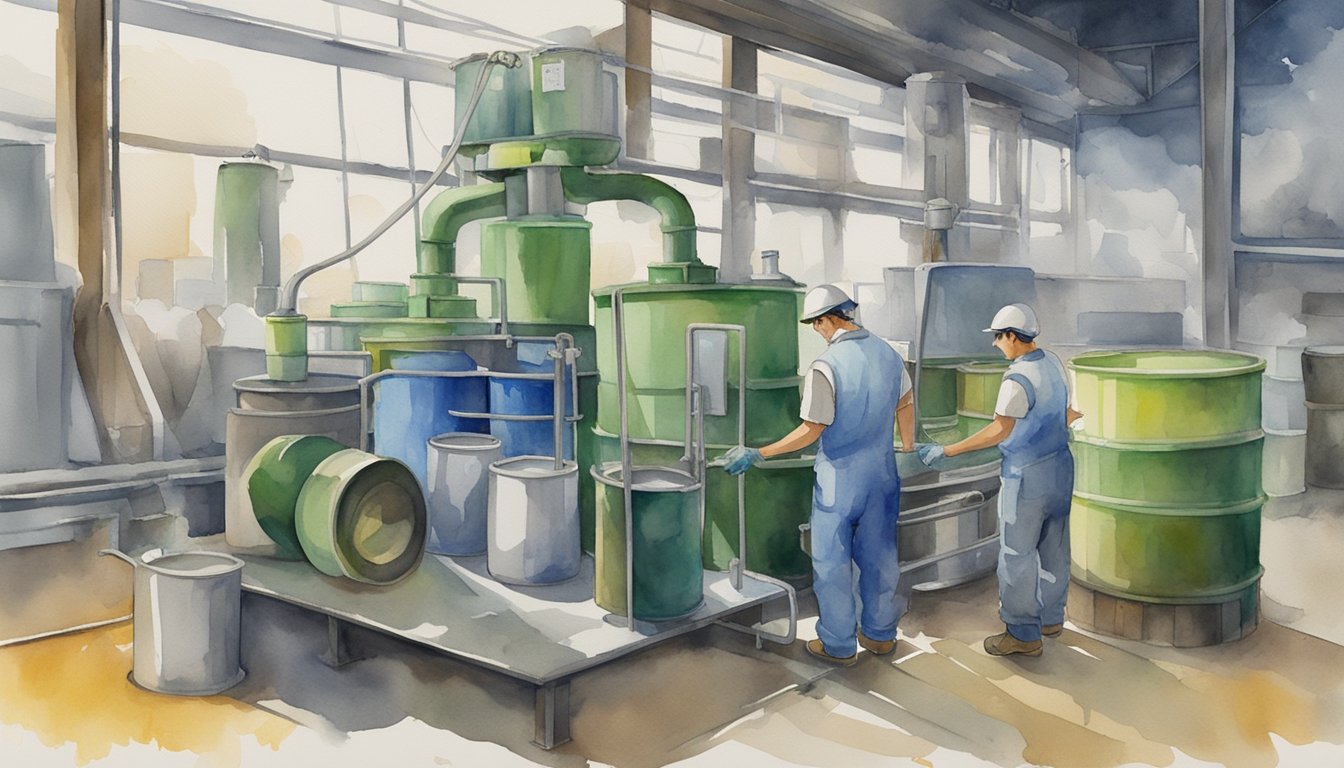When it comes to high-purity solvents, what's the difference between HPLC and LC-MS grade? Does it matter? If so, how?
In short, yes. There is a distinct difference between solvent grades when it comes to HPLC and LC-MS purposes. Even though both systems require the extremely low concentrations of impurities for their analyses, LC-MS (Liquid Chromatography-Mass Spectrometry) requires an even higher level of purity than HPLC (High-Performance Liquid Chromatography) due to higher sensitivity to a wider range of contaminants. Because of this, LC-MS-grade solvents may work just fine for HPLC purposes, although the purity is higher than the necessary level needed for liquid chromatography. On the other hand, HPLC-grade solvents may affect reproducibility of test results and damage equipment if used in LC-MS or a mass spectrometer.
Since mass spectrometers and their detectors are highly sensitive to extremely small traces of impurities or contaminants, LC-MS solvents have more stringent purity requirements than HPLC and other analysis techniques. While the absolute difference in purity may seem small, as both require well over 99.9% purity, the relative difference in purity requirements can span orders of magnitude. Depending on the impurity, For HPLC experiments, contaminants at concentrations in the low parts per million range are acceptable, but the impurity threshold for LC-MS solvents is often below 10 parts per billion, depending on the impurity. For context, 10 parts per million of impurities corresponds to 99.999% pure, while 10 parts per billion of impurities is 99.999999% pure!
Differentiating Solvent Grades
High-Performance Liquid Chromatography (HPLC) and Liquid Chromatography-Mass Spectrometry (LC-MS) solvents are specifically formulated to meet the rigorous needs of their respective techniques. HPLC solvents must have minimal non-volatile residue. They are filtered through 0.2 or 0.45-micron or smaller filters to eliminate harmful particles. These solvents must be at least 99.9% pure to avoid interfering with the analysis. Detectors in HPLC are less sensitive to impurities that do not have strong UV absorbance.
In contrast, LC-MS solvents need even higher purity levels, often surpassing HPLC standards by removing additional impurities that could affect the mass spectrometry detector. They typically undergo further testing, such as the reliable reserpine test, which is run in both electrospray ionization (ESI) and atmospheric chemical pressure ionization (APCI) tests to ensure high purity with only a few billionths of a percentile in impurities.
Solvent Purity Impacts on LC-MS Interferences
While it’s clear that a general laboratory-grade solvent isn’t appropriate for highly sensitive analytical techniques, there are still questions around whether high-performance liquid chromatography (HPLC) grade solvents can be used instead of LC-MS grade. In reality, this choice can have significant impacts, as LC-MS-grade solvents go through extra purification steps to remove trace metals and other impurities that could interfere with analysis.
Particulate matter can block inlet and in-line filters, causing technical issues with instruments such as column life span reduction and machinery downtime. This makes it crucial to select LC-MS solvents pre-filtered with a 0.2 μm (or smaller) filter to eliminate these impurities.
Solvents used in LC-MS and UV-based methods must meet stringent purity standards to avoid interference with analytical signals. Compounds with ultraviolet-visible (UV-Vis) absorbance—such as residual organic acids—can introduce baseline noise in diode-array detection systems, disrupting spectral clarity. A stable, low-drift baseline is necessary for accurate absorbance measurement, especially when analyzing compounds at low concentrations.
In mass spectrometry, background ions originating from solvent impurities can affect sensitivity and compromise detection limits. Solvents selected for trace analysis should exhibit low background signal across the mass range of interest. Plasticizers, phthalates, and other manufacturing-related contaminants may enter the solvent from contact with surfaces or storage materials during production. These residual compounds can contribute to spectral noise or introduce unexpected peaks.
To maintain data quality, solvent producers must monitor potential contamination sources throughout manufacturing and packaging. Controlling these variables supports consistent solvent performance and helps preserve accuracy in sensitive analytical workflows.
In electrospray ionization (ESI) analyses, the formation of metal adduct ions can complicate interpretation of mass spectra. Alkali metals such as sodium and potassium often associate with ionized analyte fragments, altering their mass-to-charge ratios. These interactions introduce additional peaks that may overlap with the target signal, making spectral deconvolution more challenging.
Adduct formation can also vary from one run to another, affecting consistency in quantification and identification. Such variability may lead to shifts in ion response, complicating method reproducibility and data interpretation.
Volatile salts, such as ammonium-based additives, are less prone to forming metal adducts, and are commonly used to reduce this issue. In addition, solvents used in ESI should be assessed for trace metal content and ionic contaminants. Even low levels of residual ions can lead to suppression effects or contribute to inconsistent adduct formation.
Careful selection and verification of solvent purity—especially regarding trace metals—supports more stable ionization conditions and helps maintain the reliability of ESI-MS data.
Benefits of HPLC grade solvents
While LC-MS applications require solvents that met HPLC purity standards, certain factors are crucial specifically for mass spectrometry applications that may be less important for HPLC-only applications:
-
Ultra-low Metal Ion Content: LC-MS solvents are purified to reduce metal ions like sodium, potassium, or iron that can interfere with MS sensitivity and cause unwanted adduct formation. For HPLC, such rigorous reduction of metal ions isn't usually required, as metal adducts don’t affect UV or fluorescence detection. However, in specific HPLC applications involving chelating agents or ion-pairing methods, metal ions may still impact performance.
-
Minimized Mass Background: LC-MS solvents undergo extra filtration to reduce any background ions that may appear on the MS spectrum. This level of background control is unnecessary for HPLC, where detection is influenced by UV-absorbance.
-
Volatile Contaminants Control: LC-MS solvents are specifically refined to minimize volatile organic contaminants that could interfere with MS readings. These contaminants are less of an issue for HPLC, where volatility doesn’t directly influence detection methods like UV or PDA, unless the volatile contaminant has strong UV-absorption.
-
Ion Suppression and Enhanced Purification for Low Detection Limits: LC-MS analyses are often conducted at very low analyte concentrations, requiring solvents that minimize ion suppression to maintain signal intensity. In HPLC, ion suppression is not a concern because the detection methods do not rely on ionization, so stringent ion suppression measures aren’t necessary.
-
Consistency in Baseline Stability for MS: LC-MS grade solvents are designed to provide a stable baseline in mass spectrometry, minimizing noise due to impurities. HPLC doesn’t require this level of consistency, as its baseline stability is generally unaffected by the same level of trace contaminants.
Because LC solvents without MS applications do not require these specifications, other factors such as ease of use and cost-effectiveness make HPLC solvents more attractive for their specific purpose. Since liquid chromatography excels in separation capabilities, HPLC-grade solvents are an optimal and economic choice for their application.
Common Solvents Used in HPLC and LC-MS
Both HPLC and LC-MS methods rely on solvents that support effective separation and detection. Acetonitrile and methanol are frequently selected due to their physical properties and compatibility with a wide range of analytes. In LC-MS workflows, mixtures of methanol and water are widely used for their ability to promote efficient ionization in electrospray and atmospheric pressure ionization sources.
The use of LC-MS grade water combined with appropriate additives can support more stable signals and consistent separation behavior. Additionally, solvent gradient design plays a central role in retention and resolution. Gradual shifts in solvent composition allow analytes to separate based on polarity and interaction with the stationary phase.
Selecting solvents based on analytical requirements—including analyte chemistry, ionization conditions, and method goals—supports consistent performance across runs.
Impurities Found in Different Solvents
When choosing solvents for HPLC and LC-MS applications, it's important to consider impurities that can affect the results. Different solvents may contain various impurities that can alter their performance. Understanding these impurities helps you choose the best solvent for your needs.
-
Water: Water used in chromatography should be free from ions and organic compounds. Impurities may include ions like calcium and magnesium, which can interfere with analyses.
-
Methanol: This solvent can contain trace metal impurities such as aluminum, barium, and cadmium. These metals can affect the sensitivity of your analysis and lead to unwanted peaks and enhance background noise.
-
Acetonitrile: In acetonitrile, you may encounter metal ions, with aluminum and calcium being the most common. These impurities can lead to fluctuations in the baseline and inaccurate results.
-
Isopropyl Alcohol: Common impurities in isopropyl alcohol include peroxides and aldehydes. These can cause degradation of samples or changes in the retention times of analytes.
-
Dichloromethane: This solvent may contain stability-related impurities like hydrochloric acid and water. These contaminants can cause issues with column longevity issues and increased baseline noise.
-
Tetrahydrofuran (THF): THF often contains peroxides, especially if not stored properly. Peroxide accumulation can lead to hazards in the lab and impact the degradation of analytes during separation.
Given these factors, HPLC can be very effective for routine analysis and situations where you do not need extensive molecular identification. It stands as a valuable method in various laboratories for these practical reasons. On the other hand, LC-MS combines the strengths of HPLC with additional tools for structural elucidation and detection. This combination results in a versatile analytical technique, suitable for a wide range of research and industrial applications.
Quick Comparison:
|
Feature |
HPLC |
LC-MS |
|
Purpose |
Separation of compounds |
Separation and molecular identification |
|
Sensitivity |
Moderate |
High, useful for trace-level detection |
|
Applications |
Chemical analysis |
Pharmaceuticals, environmental pollutants, and biological laboratories |
|
Cost |
Lower Equipment Costs |
Higher Costs |
|
Ease of Use |
Less Complex Operation |
More Complex |
|
Sample Integrity |
No Ionization Required |
Ionization Required |













